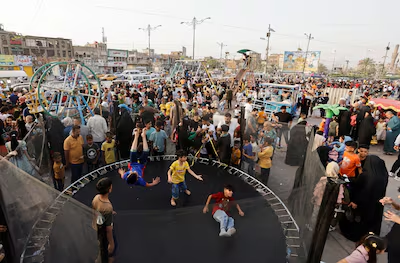At least 40 per cent of Iraq’s population is younger than 15, according to the latest estimates by its Ministry of Planning, which were based on a 2022 assessment by the Central Statistical Organisation.
“The estimated population of Iraq for the year 2022 amounted to 42,248,883 individuals with an annual increase rate of 2.5 per cent,” ministry spokesman Abdul Zahra Al Hindawi told the Iraqi News Agency.
Iraq’s population first crossed the 40 million mark in 2020, growing rapidly over the decades. Next year will mark 20 years since the 2003 US-led invasion of Iraq and at the time, the UN estimated Iraq's population was around 25 million.
Iraq's young population has long been a concern because of the large number of Iraqis entering the workforce each year — an estimated 700,000 school or college leavers. Many are unable to find gainful employment, which forces them to rely on the state for free or nearly free public services, such as electricity and clean water, as well as subsidised food, with demand often outstripping supply.
Protests across the country, mainly driven by unemployed young people, have rocked the political establishment, leading former prime minister Adil Abulmahdi to resign in early 2020 after security forces shot dead at least 500 demonstrators. Government policy has barely changed since then, as it has attempted to alleviate the unemployment crisis through public sector job creation.
Government salaries however, are only sustainable in Iraq when oil prices are high. The new government of Prime Minister Mohammad Shia Al Sudani has already created another 100,000 public sector jobs, raising the question of what will happen if oil prices fall substantially. Iraq has struggled to expand its private sector, which accounts for about 40 per cent of all jobs, according to the UN.
Males account for 50.5 per cent of the population and females 49.5 per cent, according to the government data. The number of births in the past year surpassed 1.34 million, while 236,469 people died.

The ministry said those of working age ― 15 to 64 years old ― made up 56.5 per cent of the population while the percentage of those aged 65 years and over reached 3.1 per cent of the total population.
Life expectancy at birth for the population was 74.5 years — with 72.5 for males and 76.6 for females.
The urban population amounted to 69.9 per cent of the total, with the remaining 30.1 per cent living in rural areas.
Baghdad governorate has the highest percentage of the population ― its residents exceeded nine million in 2022 ― while Al Muthanna governorate ranked last in terms of population, accounting for just 2.1 per cent of Iraq’s population.
In the absence of a national census, Iraq’s Central Organisation for Statistics and Information Technology conducts the calculation based mainly on the country's annual growth or birth rate. The vast majority of Iraqis hold some form of official national identify document, which can be used to collect food rations based on means testing, or access other government and legal services. Iraq rolled out a biometric ID card in 2016 under a system run by the Ministry of Interior, rather than the Ministry of Planning, which conducts the census.
A national census was scheduled to be held in November 2020 but was postponed because of a lack of money amid an economic crisis and the Covid-19 pandemic, Mr Al Hindawi told The National in 2021.




